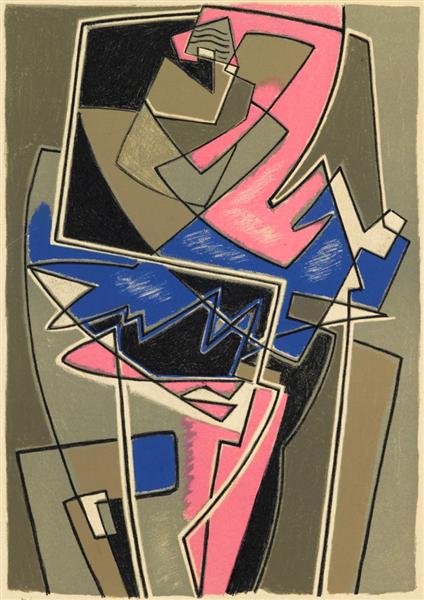Description
The painting "Ballerina - 1954" by Gino Severini stands as a masterpiece that encapsulates the essence of the future and movement, intrinsic characteristics in the style of the artist, who is an outstanding representative of Cubism and futurism. When observing this piece, you can see how Severini continues its exploration of the representation of the movement and modern life through a treatment of space and the time that resonates with the rhythm of dance, central theme of the work.
The composition of "dancer" is a brilliant exercise of balance and symmetry. The central figure of the dancer, represented in a dynamic posture, unfolds between vibrant planes, capturing the impetus and the grace that only the art of dance can transmit. The background, composed of a color palette that moves between blue, pink and green, not only complements the main figure, but also suggests a festive and energetic atmosphere that resonates with the bustle of urban life in the that Severini was soaked.
One of the most notable aspects of this work is the way Severini uses color. The dancer, although simplified, comes alive through a delicate juxtaposition of tones. Soft transitions between colors seem to suggest a constant movement, as if the figure were in the middle of a turn or jump. This approach is not only visually stimulating, but also reflects the influence of futurism, which seeks to capture the dynamism of modern time. The lines that emerge from their figure seem to expand out, emphasizing the sensation of movement, a distinctive trait of Severini that differentiates it from other cubists from their time.
Severini, who spent part of his career in Paris, was influenced by the modernity that surrounded the ballet and dance. It is remarkable that the dancer in this work is not only a tribute to the art of dance, but also to modernity itself: a symbol of freedom, expression and creativity in contemporary life. This ideal is aligned with its futuristic vision, where machine and art converge in a celebration of modern life.
The figure of the dancer, although represented in a stylized way, evokes the elegance and accumulated strength of the dancers who participated in the productions of her time, reflecting a deep admiration for the art of movement. Severini, in its inquiry of space and perspective, avoids the traditional portrait to deliver an interpretation that transcends the merely figurative, thus achieving an emotional connection that goes beyond the visual.
While "dancer - 1954" may not be one of the most commented works in the Severini Corpus, it is undoubtedly a manifestation of its technical mastery and its continuous search to unite the form and movement in an innovative visual conversation. His contribution to the development of Cubism and futurism is marked not only by its formal innovations, but also for its ability to capture the essence of modern life and its intrinsic rhythms. Thus, this work is a testimony of Severini's ingenuity and its ability to transform the everyday into something sublime, revealing the beauty and chaos of existence through its artistic lens.
KUADROS ©, a famous paint on your wall.
Hand-made oil painting reproductions, with the quality of professional artists and the distinctive seal of KUADROS ©.
Art reproduction service with satisfaction guarantee. If you are not completely satisfied with the replica of your painting, we refund your money 100%.

